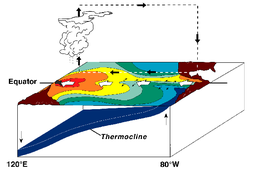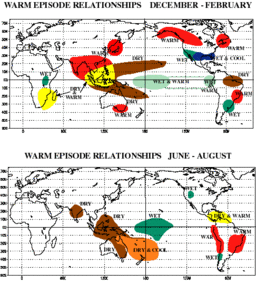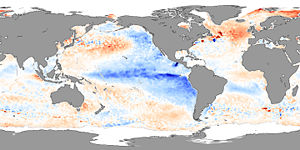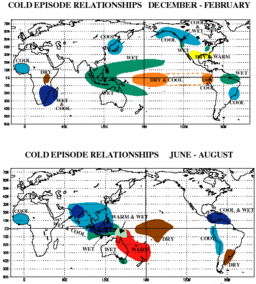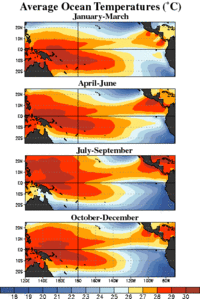- El Niño-Southern Oscillation
-
"El Niño" redirects here. For other uses, see El Niño (disambiguation)."ENSO" redirects here. For other uses, see Enso (disambiguation).
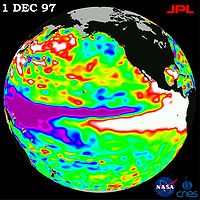 The 1997 El Niño observed by TOPEX/Poseidon. The white areas off the tropical coasts of South and North America indicate the pool of warm water.[1]
The 1997 El Niño observed by TOPEX/Poseidon. The white areas off the tropical coasts of South and North America indicate the pool of warm water.[1]
El Niño/La Niña-Southern Oscillation, or ENSO, is a quasiperiodic climate pattern that occurs across the tropical Pacific Ocean roughly every five years. It is characterized by variations in the temperature of the surface of the tropical eastern Pacific Ocean—warming or cooling known as El Niño and La Niña respectively—and air surface pressure in the tropical western Pacific—the Southern Oscillation. The two variations are coupled: the warm oceanic phase, El Niño, accompanies high air surface pressure in the western Pacific, while the cold phase, La Niña, accompanies low air surface pressure in the western Pacific.[2][3] Mechanisms that cause the oscillation remain under study.
ENSO causes extreme weather (such as floods and droughts) in many regions of the world. Developing countries dependent upon agriculture and fishing, particularly those bordering the Pacific Ocean, are the most affected. In popular usage, the El Niño-Southern Oscillation is often called just "El Niño". El Niño is Spanish for "the little boy" and refers to the Christ child, because periodic warming in the Pacific near South America is usually noticed around Christmas.[4]
Definition
El Niño is defined by prolonged differences in Pacific Ocean surface temperatures when compared with the average value. The accepted definition is a warming or cooling of at least 0.5 °C (0.9 °F) averaged over the east-central tropical Pacific Ocean. Typically, this anomaly happens at irregular intervals of 2–7 years and lasts nine months to two years.[5] The average period length is 5 years. When this warming or cooling occurs for only seven to nine months, it is classified as El Niño/La Niña "conditions"; when it occurs for more than that period, it is classified as El Niño/La Niña "episodes".[6]
The first signs of an El Niño are:
- Rise in surface pressure over the Indian Ocean, Indonesia, and Australia
- Fall in air pressure over Tahiti and the rest of the central and eastern Pacific Ocean
- Trade winds in the south Pacific weaken or head east
- Warm air rises near Peru, causing rain in the northern Peruvian deserts
- Warm water spreads from the west Pacific and the Indian Ocean to the east Pacific. It takes the rain with it, causing extensive drought in the western Pacific and rainfall in the normally dry eastern Pacific.
El Niño's warm rush of nutrient-poor tropical water, heated by its eastward passage in the Equatorial Current, replaces the cold, nutrient-rich surface water of the Humboldt Current. When El Niño conditions last for many months, extensive ocean warming and the reduction in Easterly Trade winds limits upwelling of cold nutrient-rich deep water and its economic impact to local fishing for an international market can be serious.[7]
Early stages and characteristics of El Niño
Although its causes are still being investigated, El Niño events begin when trade winds, part of the Walker circulation, falter for many months. A series of Kelvin waves—relatively warm subsurface waves of water a few centimetres high and hundreds of kilometres wide—cross the Pacific along the equator and create a pool of warm water near South America, where ocean temperatures are normally cold due to upwelling. The weakening of the winds can also create twin cyclones, another sign of a future El Niño.[8] The Pacific Ocean is a heat reservoir that drives global wind patterns, and the resulting change in its temperature alters weather on a global scale.[9] Rainfall shifts from the western Pacific toward the Americas, while Indonesia and India become drier.[10]
Jacob Bjerknes in 1969 contributed to an understanding of ENSO by suggesting that an anomalously warm spot in the eastern Pacific can weaken the east-west temperature difference, disrupting trade winds that push warm water to the west. The result is increasingly warm water toward the east.[11] Several mechanisms have been proposed through which warmth builds up in equatorial Pacific surface waters, and is then dispersed to lower depths by an El Niño event.[12] The resulting cooler area then has to "recharge" warmth for several years before another event can take place.[13]
While not a direct cause of El Niño, the Madden-Julian Oscillation, or MJO, propagates rainfall anomalies eastward around the global tropics in a cycle of 30–60 days, and may influence the speed of development and intensity of El Niño and La Niña in several ways.[14] For example, westerly flows between MJO-induced areas of low pressure may cause cyclonic circulations north and south of the equator. When the circulations intensify, the westerly winds within the equatorial Pacific can further increase and shift eastward, playing a role in El Niño development.[15] Madden-Julian activity can also produce eastward-propagating oceanic Kelvin waves, which may in turn be influenced by a developing El Niño, leading to a positive feedback loop.[16]
Southern Oscillation
 Normal Pacific pattern. Equatorial winds gather warm water pool toward west. Cold water upwells along South American coast. (NOAA / PMEL / TAO)
Normal Pacific pattern. Equatorial winds gather warm water pool toward west. Cold water upwells along South American coast. (NOAA / PMEL / TAO)
The Southern Oscillation is the atmospheric component of El Niño. This component is an oscillation in surface air pressure between the tropical eastern and the western Pacific Ocean waters. The strength of the Southern Oscillation is measured by the Southern Oscillation Index (SOI). The SOI is computed from fluctuations in the surface air pressure difference between Tahiti and Darwin, Australia.[17] El Niño episodes are associated with negative values of the SOI, meaning that the pressure difference between Tahiti and Darwin is relatively small.
High atmospheric pressure tends to occur over warm water and Low pressure occurs over cold water, in part because deep convection over the warm water acts to transport air. El Niño episodes are defined as sustained warming of the central and eastern tropical Pacific Ocean. This results in a decrease in the strength of the Pacific trade winds, and a reduction in rainfall over eastern and northern Australia.
Walker circulation
During non-El Niño conditions, the Walker circulation is seen at the surface as easterly trade winds that move water and air warmed by the sun toward the west. This also creates ocean upwelling off the coasts of Peru and Ecuador and brings nutrient-rich cold water to the surface, increasing fishing stocks. The western side of the equatorial Pacific is characterized by warm, wet low pressure weather as the collected moisture is dumped in the form of typhoons and thunderstorms. The ocean is some 60 centimetres (24 in) higher in the western Pacific as the result of this motion.[18][19][20][21]
Effects of ENSO's warm phase (El Niño)
South America
Because El Niño's warm pool feeds thunderstorms above, it creates increased rainfall across the east-central and eastern Pacific Ocean including several portions of the South American west coast. The effects of El Niño in South America are direct and stronger than in North America. An El Niño is associated with warm and very wet weather months in April–October along the coasts of northern Peru and Ecuador, causing major flooding whenever the event is strong or extreme.[22] The effects during the months of February, March and April may become critical. Along the west coast of South America, El Niño reduces the upwelling of cold, nutrient-rich water that sustains large fish populations, which in turn sustain abundant sea birds, whose droppings support the fertilizer industry. This leads to fish kills offshore Peru.[7]
The local fishing industry along the affected coastline can suffer during long-lasting El Niño events. The world's largest fishery collapsed due to overfishing during the 1972 El Niño Peruvian anchoveta reduction. During the 1982–83 event, jack mackerel and anchoveta populations were reduced, scallops increased in warmer water, but hake followed cooler water down the continental slope, while shrimp and sardines moved southward, so some catches decreased while others increased.[23] Horse mackerel have increased in the region during warm events. Shifting locations and types of fish due to changing conditions provide challenges for fishing industries. Peruvian sardines have moved during El Niño events to Chilean areas. Other conditions provide further complications, such as the government of Chile in 1991 creating restrictions on the fishing areas for self-employed fishermen and industrial fleets.
The ENSO variability may contribute to the great success of small fast-growing species along the Peruvian coast, as periods of low population removes predators in the area. Similar effects benefit migratory birds that travel each spring from predator-rich tropical areas to distant winter-stressed nesting areas.
Southern Brazil and northern Argentina also experience wetter than normal conditions but mainly during the spring and early summer. Central Chile receives a mild winter with large rainfall, and the Peruvian-Bolivian Altiplano is sometimes exposed to unusual winter snowfall events. Drier and hotter weather occurs in parts of the Amazon River Basin, Colombia, and Central America.
North America
Winters, during the El Niño effect, are warmer and drier than average in the Northwest, Northmidwest, and Northmideast United States, and therefore those regions experience reduced snowfalls. Meanwhile, significantly wetter winters are present in northwest Mexico and the southwest United States including central and southern California, while both cooler and wetter than average winters in northeast Mexico and the southeast United States (including the Tidewater region of Virginia) occur during the El Niño phase of the oscillation.[24][25]
In Canada, both warmer and drier winters (due to forcing of the Polar Jet further north) over much of the country occur, although less variation from normal is seen in the Maritime Provinces. The following summer is warmer and sometimes drier creating a more active than average forest fire season over Central/Eastern Canada.[citation needed] Some believed that the ice-storm in January 1998, which devastated parts of Southern Ontario and Southern Quebec, was caused or accentuated by El Niño's warming effects.[26] El Niño warmed Vancouver for the 2010 Winter Olympics, such that the area experienced a subtropical-like winter during the games.[27]
Summers, during the El Niño effect, are wetter than average in the Northwest, Northmidwest, Northmideast, and mountain regions of the United States.[citation needed]
El Niño is credited with suppressing hurricanes and made the 2009 hurricane season the least active in twelve years.[28] El Niño is also associated with increased wave-caused coastal erosion along the United States Pacific Coast.[citation needed]
There is some evidence that El Niño activity is correlated with incidence of red tides off the Pacific coast of California[citation needed].
Tropical cyclones
Most tropical cyclones form on the side of the subtropical ridge closer to the equator, then move poleward past the ridge axis before recurving into the main belt of the Westerlies.[29] When the subtropical ridge position shifts due to El Niño, so will the preferred tropical cyclone tracks. Areas west of Japan and Korea tend to experience much fewer September–November tropical cyclone impacts during El Niño and neutral years. During El Niño years, the break in the subtropical ridge tends to lie near 130°E, which would favor the Japanese archipelago.[30] During El Niño years, Guam's chance of a tropical cyclone impact is one-third of the long term average.[31] The tropical Atlantic ocean experiences depressed activity due to increased vertical wind shear across the region during El Niño years.[32]
Elsewhere
In Africa, East Africa - including Kenya, Tanzania, and the White Nile basin - experiences, in the long rains from March to May, wetter-than-normal conditions. There are also drier than normal conditions from December to February in south-central Africa, mainly in Zambia, Zimbabwe, Mozambique, and Botswana. Direct effects of El Niño resulting in drier conditions occur in parts of Southeast Asia and Northern Australia, increasing bush fires, worsening haze, and decreasing air quality dramatically. Drier-than-normal conditions are also in general observed in Queensland, inland Victoria, inland New South Wales, and eastern Tasmania from June to August.
Many ENSO linkages exist in the high southern latitudes around Antarctica [33]. Specifically, El Niño conditions result in high pressure anomalies over the Amundsen and Bellingshausen seas, causing reduced sea ice and increased poleward heat fluxes in these sectors as well as the Ross Sea. The Weddell Sea, conversely, tends to become colder with more sea ice during El Niño. The exact opposite heating and atmospheric pressure anomalies occur during La Niña [34].
El Niño's effects on Europe are not entirely clear, but it is not nearly as affected as at least large parts of other continents. There is some evidence that an El Niño may cause a wetter, cloudier winter in Northern Europe and a milder, drier winter in the Mediterranean Sea region. The El Niño winter of 2006/2007 was unusually mild in Europe, and the Alps recorded very little snow coverage that season.[35]
In most recent times, Singapore experienced the driest February in 2010 since records begins in 1869. With only 6.3 millimetres of rain fell in the month and temperatures hitting as high as 35 degrees Celsius on 26 February. The years 1968 and 2005 had the next driest Februaries, when 8.4 mm of rain fell.[36]
Effects of ENSO's cool phase (La Niña)
La Niña is the name for the cold phase of ENSO, during which the cold pool in the eastern Pacific intensifies and the trade winds strengthen. The name La Niña originates from Spanish, meaning "the girl", analogous to El Niño meaning "the boy". It has also in the past been called anti-El Niño, and El Viejo (meaning "the old man").[37]
Africa
La Niña results in wetter-than-normal conditions in Southern Africa from December to February, and drier-than-normal conditions over equatorial East Africa over the same period.[38]
Asia
During La Niña years, the formation of tropical cyclones, along with the subtropical ridge position, shifts westward across the western Pacific ocean, which increases the landfall threat to China.[30] In March 2008, La Niña caused a drop in sea surface temperatures over Southeast Asia by an amount of 2 °C. It also caused heavy rains over Malaysia, Philippines, and Indonesia.[39]
South America
During a time of La Niña, drought plagues the coastal regions of Peru and Chile.[40] From December to February, northern Brazil is wetter than normal.[40]
North America
La Niña causes mostly the opposite effects of El Niño. La Niña causes above-average precipitation across the North Midwest, the Northern Rockies, Northern California, and the Pacific Northwest's southern and eastern regions. Meanwhile there is below-average precipitation in the southwestern and southeastern states.[41]
La Niñas occurred in 1904, 1908, 1910, 1916, 1924, 1928, 1938, 1950, 1955, 1964, 1970, 1973, 1975, 1988, 1995.[42]
In Canada, La Niña will in general cause a cooler, snowier winter, such as the near record-breaking amounts of snow recorded in the La Niña winter of 2007/2008 in Eastern Canada.[43]
[[File:Example.jpwinter.[44]
The 2010-2011 La Niña was one of the strongest ever observed. The effect on Eastern Australia was devastating.[45]
Remote influence on tropical Atlantic Ocean
A study of climate records has shown that El Niño events in the equatorial Pacific are generally associated with a warm tropical North Atlantic in the following spring and summer.[46] About half of El Niño events persist sufficiently into the spring months for the Western Hemisphere Warm Pool (WHWP) to become unusually large in summer.[47] Occasionally, El Niño's effect on the Atlantic Walker circulation over South America strengthens the easterly trade winds in the western equatorial Atlantic region. As a result, an unusual cooling may occur in the eastern equatorial Atlantic in spring and summer following El Niño peaks in winter.[48] Cases of El Niño-type events in both oceans simultaneously have been linked to severe famines related to the extended failure of monsoon rains.[49]
ENSO and global warming
During the last several decades the number of El Niño events increased, and the number of La Niña events decreased.[50] The question is whether this is a random fluctuation or a normal instance of variation for that phenomenon or the result of global climate changes toward global warming.
The studies of historical data show that the recent El Niño variation is most likely linked to global warming. For example, one of the most recent results is that, even after subtracting the positive influence of decadal variation, shown to be possibly present in the ENSO trend,[51] the amplitude of the ENSO variability in the observed data still increases, by as much as 60% in the last 50 years.[52]
It is not certain what exact changes will happen to ENSO in the future: Different models make different predictions (cf.[53]) It may be that the observed phenomenon of more frequent and stronger El Niño events occurs only in the initial phase of the global warming, and then (e.g., after the lower layers of the ocean get warmer as well), El Niño will become weaker than it was.[54] It may also be that the stabilizing and destabilizing forces influencing the phenomenon will eventually compensate for each other.[55] More research is needed to provide a better answer to that question, but the current results do not completely exclude the possibility of dramatic changes. The ENSO is considered to be a potential tipping element in Earth's climate.[56]
El Niño "Modoki" and Central-Pacific El Niño
The traditional Niño, also called Eastern Pacific (EP) El Niño,[57] involves temperature anomalies in the Eastern Pacific. However, in the last two decades non-traditional El Niños were observed, in which the usual place of the temperature anomaly (Nino 1 and 2) is not affected, but an anomaly arises in the central Pacific (Nino 3.4).[58] The phenomenon is called Central Pacific (CP) El Niño,[57] "dateline" El Niño (because the anomaly arises near the dateline), or El Niño "Modoki" (Modoki is Japanese for "similar, but different").[59]
The effects of the CP El Niño are different from those of the traditional EP El Niño — e.g., the new El Niño leads to more hurricanes more frequently making landfall in the Atlantic.[60]
The recent discovery of El Niño Modoki has some scientists believing it to be linked to global warming.[61] However, Satellite data goes back only to 1979. More research must be done to find the correlation and study past El Niño episodes.
The first recorded El Niño that originated in the central Pacific and moved toward the east was in 1986.[62]
A joint study by the National Aeronautics and Space Administration and the National Oceanic and Atmospheric Administration concluded that climate change may contribute to stronger El Niños. El Niño "Modoki" events occurred in 1991-92, 1994–95, 2002–03, 2004–05, and 2009-10.[63] The strongest such Central Pacific El Niño event known occurred in 2009-2010.[64]
Health and social impacts of El Niño
Extreme weather conditions related to the El Niño cycle correlate with changes in the incidence of epidemic diseases. For example, the El Niño cycle is associated with increased risks of some of the diseases transmitted by mosquitoes, such as malaria, dengue, and Rift Valley fever. Cycles of malaria in India, Venezuela, and Colombia have now been linked to El Niño. Outbreaks of another mosquito-transmitted disease, Australian encephalitis ( Murray Valley encephalitis - MVE), occur in temperate south-east Australia after heavy rainfall and flooding, which are associated with La Niña events. A severe outbreak of Rift Valley fever occurred after extreme rainfall in north-eastern Kenya and southern Somalia during the 1997-98 El Niño.[65]
ENSO may be linked to civil conflicts. Scientists at the Earth Institute of Columbia University have analyzed data from 1950 to 2004 and suggest that ENSO may have had a role in 21% of all civil conflicts since 1950, with the risk of annual civil conflict doubling from 3% to 6% in countries affected by ENSO during El Niño years relative to La Niña years.[66][67]
Cultural history and pre-historic information
ENSO conditions have occurred at two- to seven year intervals for at least the past 300 years, but most of them have been weak. There is also evidence for strong El Niño events during the early Holocene epoch 10,000 years ago.[68]
El Niño affected pre-Columbian Incas [69] and may have led to the demise of the Moche and other pre-Columbian Peruvian cultures.[70] A recent study suggests that a strong El-Niño effect between 1789–93 caused poor crop yields in Europe, which in turn helped touch off the French Revolution.[71] The extreme weather produced by El Niño in 1876–77 gave rise to the most deadly famines of the 19th century.[72]
An early recorded mention of the term "El Niño" to refer to climate occurs in 1892, when Captain Camilo Carrillo told the Geographical society congress in Lima that Peruvian sailors named the warm northerly current "El Niño" because it was most noticeable around Christmas. The phenomenon had long been of interest because of its effects on the guano industry and other enterprises that depend on biological productivity of the sea.
Charles Todd, in 1893, suggested that droughts in India and Australia tended to occur at the same time; Norman Lockyer noted the same in 1904. An El Niño connection with flooding was reported in 1895 by Pezet and Eguiguren. In 1924, Gilbert Walker (for whom the Walker circulation is named) coined the term "Southern Oscillation".
The major 1982–83 El Niño led to an upsurge of interest from the scientific community. The period from 1990–1994 was unusual in that El Niños have rarely occurred in such rapid succession.[73] An especially intense El Niño event in 1998 caused an estimated 16% of the world's reef systems to die. The event temporarily warmed air temperature by 1.5 °C, compared to the usual increase of 0.25 °C associated with El Niño events.[74] Since then, mass coral bleaching has become common worldwide, with all regions having suffered "severe bleaching".[75]
Major ENSO events were recorded in the years 1790–93, 1828, 1876–78, 1891, 1925–26, 1972–73, 1982–83, and 1997–98, with 2010–2011 being one of the strongest ever.[49][verification needed]
Climate Networks
Analysis of El-Nino events using climate networks show that the dynamics of the climate network is very sensitive to El-Nino events. Many links in the network fail during El-Nino events [76].
See also
References
- ^ "Independent NASA Satellite Measurements Confirm El Niño is Back and Strong". NASA/JPL. http://www.jpl.nasa.gov/news/releases/97/elninoup.html.
- ^ Climate Prediction Center (2005-12-19). "Frequently Asked Questions about El Niño and La Niña". National Centers for Environmental Prediction. http://www.cpc.noaa.gov/products/analysis_monitoring/ensostuff/ensofaq.shtml#DIFFER. Retrieved 2009-07-17.
- ^ K.E. Trenberth, P.D. Jones, P. Ambenje, R. Bojariu , D. Easterling, A. Klein Tank, D. Parker, F. Rahimzadeh, J.A. Renwick, M. Rusticucci, B. Soden and P. Zhai. "Observations: Surface and Atmospheric Climate Change". In Solomon, S., D. Qin, M. Manning, Z. Chen, M. Marquis, K.B. Averyt, M. Tignor and H.L. Miller. Climate Change 2007: The Physical Science Basis. Contribution of Working Group I to the Fourth Assessment Report of the Intergovernmental Panel on Climate Change. Cambridge,UK: Cambridge University Press. pp. 235–336. http://www.ipcc.ch/publications_and_data/ar4/wg1/en/ch3.html.
- ^ "El Niño Information". California Department of Fish and Game, Marine Region. http://www.dfg.ca.gov/marine/elnino.asp.
- ^ Climate Prediction Center (2005-12-19). "ENSO FAQ: How often do El Niño and La Niña typically occur?". National Centers for Environmental Prediction. http://www.cpc.noaa.gov/products/analysis_monitoring/ensostuff/ensofaq.shtml#HOWOFTEN. Retrieved 2009-07-26.
- ^ National Climatic Data Center (June 2009). "El Niño / Southern Oscillation (ENSO) June 2009". National Oceanic and Atmospheric Administration. http://www.ncdc.noaa.gov/oa/climate/research/enso/?year=2009&month=6&submitted=true. Retrieved 2009-07-26.
- ^ a b WW2010 (1998-04-28). "El Niño". University of Illinois at Urbana-Champaign. http://ww2010.atmos.uiuc.edu/(Gh)/guides/mtr/eln/home.rxml. Retrieved 2009-07-17.
- ^ Tim Liu (2005-09-06). "El Niño Watch from Space". National Aeronautics and Space Administration. http://airsea-www.jpl.nasa.gov/ENSO/welcome.html. Retrieved 2010-05-31.
- ^ Stewart, Robert (2009-01-06). "El Niño and Tropical Heat". Our Ocean Planet: Oceanography in the 21st Century. Department of Oceanography, Texas A&M University. http://oceanworld.tamu.edu/resources/oceanography-book/heatbudgets.htm. Retrieved 2009-07-25.
- ^ Dr. Tony Phillips (2002-03-05). "A Curious Pacific Wave". National Aeronautics and Space Administration. http://science.nasa.gov/headlines/y2002/05mar_kelvinwave.htm. Retrieved 2009-07-24.
- ^ Nova (1998). "1969". Public Broadcasting Service. http://www.pbs.org/wgbh/nova/elnino/reach/1969.html. Retrieved 2009-07-24.
- ^ De-Zheng Sun (2007). Nonlinear Dynamics in Geosciences: 29 The Role of El Niño—Southern Oscillation in Regulating its Background State. Springer. doi:10.1007/978-0-387-34918-3. ISBN 978-0-387-34917-6. http://www.springerlink.com/content/r48078945n5w086v/. Retrieved 2009-07-24.
- ^ Soon-Il An and In-Sik Kang (2000). "A Further Investigation of the Recharge Oscillator Paradigm for ENSO Using a Simple Coupled Model with the Zonal Mean and Eddy Separated". Journal of Climate 13 (11): 1987–93. Bibcode 2000JCli...13.1987A. doi:10.1175/1520-0442(2000)013<1987:AFIOTR>2.0.CO;2. ISSN 1520-0442. http://ams.allenpress.com/perlserv/?request=get-document&doi=10.1175%2F1520-0442(2000)013%3C1987%3AAFIOTR%3E2.0.CO%3B2. Retrieved 2009-07-24.
- ^ Jon Gottschalck and Wayne Higgins (2008-02-16). "Madden Julian Oscillation Impacts". Climate Prediction Center. http://www.cpc.ncep.noaa.gov/products/precip/CWlink/MJO/MJO_1page_factsheet.pdf. Retrieved 2009-07-24.
- ^ Air-Sea Interaction & Climate (2005-09-06). "El Niño Watch from Space". Jet Propulsion Laboratory California Institute of Technology. http://airsea-www.jpl.nasa.gov/ENSO/welcome.html. Retrieved 2009-07-17.
- ^ Eisenman, Ian; Yu, Lisan; Tziperman, Eli (2005). "Westerly Wind Bursts: ENSO's Tail Rather than the Dog?". Journal of Climate 18 (24): 5224–38. Bibcode 2005JCli...18.5224E. doi:10.1175/JCLI3588.1.
- ^ "Climate glossary - Southern Oscilliation Index (SOI)". Bureau of Meteorology (Australia). 2002-04-03. http://www.bom.gov.au/climate/glossary/soi.shtml. Retrieved 2009-12-31.
- ^ Pidwirny, Michael (2006-02-02). "Chapter 7: Introduction to the Atmosphere". Fundamentals of Physical Geography. physicalgeography.net. http://www.physicalgeography.net/fundamentals/7z.html. Retrieved 2006-12-30.
- ^ "Envisat watches for La Niña". BNSC via the Internet Wayback Machine. 2011-01-09. Archived from the original on 2008-04-24. http://web.archive.org/web/20080424113710/http://www.bnsc.gov.uk/content.aspx?nid=5989. Retrieved 2007-07-26.
- ^ "The Tropical Atmosphere Ocean Array: Gathering Data to Predict El Niño". Celebrating 200 Years. NOAA. 2007-01-08. http://celebrating200years.noaa.gov/datasets/tropical/welcome.html. Retrieved 2007-07-26.
- ^ "Ocean Surface Topography". Oceanography 101. JPL. 2006-07-05. http://sealevel.jpl.nasa.gov/gallery/presentations/oceanography-101/ocean101-slide14.html. Retrieved 2007-07-26."Annual Sea Level Data Summary Report July 2005 - June 2006" (PDF). The Australian Baseline Sea Level Monitoring Project. Bureau of Meteorology. Archived from the original on 2007-08-07. http://web.archive.org/web/20070807235141/http://www.bom.gov.au/fwo/IDO60202/IDO60202.2006.pdf. Retrieved 2007-07-26.
- ^ "Atmospheric Consequences of El Niño". University of Illinois. http://ww2010.atmos.uiuc.edu/%28Gh%29/guides/mtr/eln/atms.rxml. Retrieved 2010-05-31.
- ^ Pearcy, W. G.; Schoener, A. (1987). "Changes in the marine biota coincident with the 1982-1983 El Niño in the northeastern subarctic Pacific Ocean". Journal of Geophysical Research 92 (C13): 14417–28. Bibcode 1987JGR....9214417P. doi:10.1029/JC092iC13p14417. http://www.agu.org/pubs/crossref/1987/JC092iC13p14417.shtml.
- ^ Climate Prediction Center. Average October-December (3-month) Temperature Rankings During ENSO Events. Retrieved on 2008-04-16.
- ^ Climate Prediction Center. Average December-February (3-month) Temperature Rankings During ENSO Events. Retrieved on 2008-04-16.
- ^ http://www.davidsuzuki.org/Climate_Change/Impacts/Extreme_Weather/El_Nino.asp
- ^ http://news.nationalgeographic.com/news/2010/02/100212-vancouver-2010-warmest-winter-olympics/
- ^ Brian K. Sullivan (2010-05-06). "El Niño Warning Will Fade Out by June, U.S. Says (Update 1)". Bloomberg Businessweek. http://www.businessweek.com/news/2010-05-06/el-nino-warming-will-fade-out-by-june-u-s-says-update1-.html. Retrieved 2010-05-31.
- ^ Joint Typhoon Warning Center (2006). 3.3 JTWC Forecasting Philosophies. United States Navy. Retrieved on 2007-02-11.
- ^ a b M. C. Wu, W. L. Chang, and W. M. Leung (2003). Impacts of El Niño-Southern Oscillation Events on Tropical Cyclone Landfalling Activity in the Western North Pacific. Journal of Climate: pp. 1419–1428. Retrieved on 2007-02-11.
- ^ Pacific ENSO Applications Climate Center. Pacific ENSO Update: 4th Quarter, 2006. Vol. 12 No. 4. Retrieved on 2008-03-19.
- ^ Edward N. Rappaport (September 1999). "Atlantic Hurricane Season of 1997". Monthly Weather Review 127: 2012. Bibcode 1999MWRv..127.2012R. doi:10.1175/1520-0493(1999)127<2012:AHSO>2.0.CO;2. http://www.aoml.noaa.gov/general/lib/lib1/nhclib/mwreviews/1997.pdf. Retrieved 2009-07-18.
- ^ Turner, John (2004). "The El Niño-Southern Oscillation and Antarctica". International Journal of Climatology 24: 1–31. Bibcode 2004IJCli..24....1T. doi:10.1002/joc.965.
- ^ Yuan, Xiaojun (2004). "ENSO-related impacts on Antarctic sea ice: a synthesis of phenomenon and mechanisms". Antarctic Science 16 (4): 415–425. doi:10.1017/S0954102004002238.
- ^ "Concern over Europe 'snow crisis'". BBC News. 2006-12-17. http://news.bbc.co.uk/2/hi/europe/6185345.stm. Retrieved 2010-05-01.
- ^ http://www.channelnewsasia.com/stories/singaporelocalnews/view/1040778/1/.html
- ^ Tropical Atmosphere Ocean project (2008-03-24). "What is La Niña?". Pacific Marine Environmental Laboratory. http://www.pmel.noaa.gov/tao/elnino/la-nina-story.html. Retrieved 2009-07-17.
- ^ http://www.scoop.co.nz/stories/WO1010/S00173/la-nina-weather-likely-to-last-for-months.htm
- ^ Hong, Lynda (2008-03-13). "Recent heavy rain not caused by global warming". Channel NewsAsia. http://www.channelnewsasia.com/stories/singaporelocalnews/view/334735/1/.html. Retrieved 2008-06-22.
- ^ a b "La Niña follows El Niño, the GLOBE El Niño Experiment continues". http://classic.globe.gov/fsl/html/templ.cgi?butler_lanina&lang=en. Retrieved 2010-05-31.
- ^ "ENSO Diagnostic Discussion". Climate Prediction Center. 2008-06-05. http://www.cpc.noaa.gov/products/analysis_monitoring/enso_advisory/ensodisc.html.
- ^ "La Niña Information". http://www.publicaffairs.noaa.gov/lanina.html. Retrieved 2010-05-31.
- ^ http://www.ec.gc.ca/doc/smc-msc/2008/s3_eng.html
- ^ http://www.cpc.noaa.gov/products/analysis_monitoring/lanina/enso_evolution-status-fcsts-web.pdf
- ^ http://www.bom.gov.au/climate/enso/feature/ENSO-feature.shtml
- ^ David B. Enfield and Dennis A. Mayer (1997). "Tropical Atlantic sea surface temperature variability and its relation to El Niño-Southern Oscillation". Journal of Geophysical Research 102 (C1): 929–945. Bibcode 1997JGR...102..929E. doi:10.1029/96JC03296. http://www.agu.org/pubs/crossref/1997/96JC03296.shtml. Retrieved 2009-11-29.
- ^ Sang-Ki Lee, Chunzai Wang and David B. Enfield (2008). "Why do some El Niños have no impact on tropical North Atlantic SST?". Geophysical Research Letters 35 (L16705): L16705. Bibcode 2008GeoRL..3516705L. doi:10.1029/2008GL034734. http://www.agu.org/pubs/crossref/2008/2008GL034734.shtml. Retrieved 2009-11-29.
- ^ M. Latif and A. Grötzner (2000). "The equatorial Atlantic oscillation and its response to ENSO". Climate Dynamics 16 (2–3): 213–218. Bibcode 2000ClDy...16..213L. doi:10.1007/s003820050014. http://www.springerlink.com/content/1hjeatc9jjlb0lh2/?p=038dacb0cb4140679f406a9ebed3304a&pi=0. Retrieved 2009-11-29.
- ^ a b Davis, Mike (2001). Late Victorian Holocausts: El Niño Famines and the Making of the Third World. London: Verso. pp. 271. ISBN 1859847390.
- ^ Trenberth, Kevin E.; Hoar, Timothy J. (January 1996). "The 1990-1995 El Niño-Southern Oscillation event: Longest on record". Geophysical Research Letters 23 (1): 57&–;60. Bibcode 1996GeoRL..23...57T. doi:10.1029/95GL03602.
- ^ Fedorov, Alexey V.; Philander, S. George (2000). "Is El Niño Changing?". Science 288 (5473): 1997–2002. Bibcode 2000Sci...288.1997F. doi:10.1126/science.288.5473.1997.
- ^ Zhang, Qiong; Guan, Yue; Yang, Haijun (2008). "ENSO Amplitude Change in Observation and Coupled Models". Advances in Atmospheric Sciences 25 (3): 331–6. Bibcode 2008AdAtS..25..361Z. doi:10.1007/s00376-008-0361-5.
- ^ Merryfield, William J. (2006). "Changes to ENSO under CO2 Doubling in a Multimodel Ensemble". Journal of Climate 19 (16): 4009–27. Bibcode 2006JCli...19.4009M. doi:10.1175/JCLI3834.1. http://www.ocgy.ubc.ca/~yzq/books/paper5_IPCC_revised/Merryfield2006.pdf.
- ^ Meehl, G. A.; Teng, H.; Branstator, G. (2006). "Future changes of El Niño in two global coupled climate models". Climate Dynamics 26 (6): 549. Bibcode 2006ClDy...26..549M. doi:10.1007/s00382-005-0098-0.
- ^ Philip, S.; Van Oldenborgh, G. J. (2006). "Shifts in ENSO coupling processes under global warming". Geophysical Research Letters 33 (11). doi:10.1029/2006GL026196.
- ^ Lenton, T. M.; Held, H.; Kriegler, E.; Hall, J. W.; Lucht, W.; Rahmstorf, S.; Schellnhuber, H. J. (Feb 2008). "Tipping elements in the Earth's climate system" (Free full text). Proceedings of the National Academy of Sciences 105 (6): 1786–1793. Bibcode 2008PNAS..105.1786L. doi:10.1073/pnas.0705414105. PMC 2538841. PMID 18258748. http://www.pnas.org/cgi/pmidlookup?view=long&pmid=18258748.
- ^ a b Kao, Hsun-Ying and Jin-Yi Yu (2009). "Contrasting Eastern-Pacific and Central-Pacific Types of ENSO". Journal of Climate 22 (3): 615–632. Bibcode 2009JCli...22..615K. doi:10.1175/2008JCLI2309.1. http://ams.allenpress.com/perlserv/?request=get-abstract&doi=10.1175%2F2008JCLI2309.1.
- ^ Larkin, N. K.; Harrison, D. E. (2005). "On the definition of El Niño and associated seasonal average U.S. Weather anomalies". Geophysical Research Letters 32 (13): L13705. Bibcode 2005GeoRL..3213705L. doi:10.1029/2005GL022738.
- ^ Modoki: The Mimetic Tradition in Japan (article by Sakabe Magumi), p251- in Modern Japanese Aesthetics - A Reader, ed Michelle Marra, 1999, University of Hawaii Press
- ^ Hye-Mi Kim, Peter J. Webster, & Judith A. Curry (2009). "Impact of Shifting Patterns of Pacific Ocean Warming on North Atlantic Tropical Cyclones". Science 335 (5936): 77–80. Bibcode 2009Sci...325...77K. doi:10.1126/science.1174062. PMID 19574388. http://www.sciencemag.org/cgi/content/abstract/325/5936/77.
- ^ Yeh, Sang-Wook; Kug, Jong-Seong; Dewitte, Boris; Kwon, Min-Ho; Kirtman, Ben P.; Jin, Fei-Fei (September 2009). "El Niño in a changing climate". Nature 461 (7263): 511–4. Bibcode 2009Natur.461..511Y. doi:10.1038/nature08316. PMID 19779449.
- ^ Phillander, S. George (2004). Our affair with El Niño: how we transformed an enchanting Peruvian current into a global climate hazard. Princeton University Press. ISBN 0-691-11335-1.
- ^ CIT, JPL; Michael McPhaden. "NASA/NOAA Study Finds El Niños are Growing Stronger". National Aeronautics and Space Administration. Pasadena, California: Jet Propulsion Laboratory. http://www.jpl.nasa.gov/news/news.cfm?release=2010-277&cid=release_2010-277&msource=nino20100825&tr=y&auid=6878202. Retrieved 27 August 2010.
- ^ Staff, OurAmazingPlanet. "New Type of El Niño Emerges as Climate Changes". Imaginova Corporation. LiveScience. http://www.livescience.com/environment/el-nino-rising-ocean-temperatures-100830.html. Retrieved 19 September 2010.
- ^ "El Niño and its health impact". Health Topics A to Z. http://www.allcountries.org/health/el_nino_and_its_health_impact.html. Retrieved 2011-01-01..
- ^ Hsiang, S. M. , Meng, K. C. & Cane, M. A. (2011). "Civil conflicts are associated with the global climate". Nature 476: 438–441. doi:10.1038/nature10311. http://www.nature.com/nature/journal/v476/n7361/full/nature10311.html.
- ^ Quirin Schiermeier (2011). "Climate cycles drive civil war". Nature 476: 406–407. doi:10.1038/news.2011.501. http://www.nature.com/news/2011/110824/full/news.2011.501.html.
- ^ Carrè, Matthieu; et al. (2005). "Strong El Niño events during the early Holocene: stable isotope evidence from Peruvian sea shells". The Holocene 15 (1): 42–7. doi:10.1191/0959683605h1782rp.
- ^ "El Nino here to stay". BBC News. http://news.bbc.co.uk/2/hi/science/nature/25433.stm. Retrieved 2010-05-01.
- ^ Brian Fagan (1999). Floods, Famines and Emporers: El Niño and the Fate of Civilizations. Basic Books. pp. 119–138. ISBN 0-465-01120-9.
- ^ Grove, Richard H. (1998). "Global Impact of the 1789–93 El Niño". Nature 393 (6683): 318–9. Bibcode 1998Natur.393..318G. doi:10.1038/30636.
- ^ "Ó Gráda, C.: Famine: A Short History". Princeton University Press.
- ^ Trenberth, Kevin E.; Hoar, Timothy J. (1996). "The 1990-1995 El Niño-Southern Oscillation Event: Longest on Record". Geophysical Research Letters 23 (1): 57–60. Bibcode 1996GeoRL..23...57T. doi:10.1029/95GL03602. http://www.agu.org/pubs/crossref/1996/95GL03602.shtml.
- ^ Trenberth, K. E.; et al. (2002). "Evolution of El Niño – Southern Oscillation and global atmospheric surface temperatures". Journal of Geophysical Research 107 (D8): 4065. Bibcode 2002JGRD..107.4065T. doi:10.1029/2000JD000298.
- ^ Marshall, Paul; Schuttenberg, Heidi (2006). A reef manager's guide to coral bleaching. Townsville, Qld.: Great Barrier Reef Marine Park Authority. ISBN 1876945400. http://coris.noaa.gov/activities/reef_managers_guide/pdfs/reef_managers_guide.pdf.
- ^ K. Yamasaki, A. Gozolchiani, S. Havlin (2008). "Climate networks around the globe are significantly affected by El Nino". Phys. Rev. Lett 100: 228501. Bibcode 2008PhRvL.100c8501L. doi:10.1103/PhysRevLett.100.038501. http://havlin.biu.ac.il/Publications.php?keyword=Climate+networks+around+the+globe+are+significantly+affected+by+El+Nino&year=*&match=all.
Further reading
- Caviedes, César N. (2001). El Niño in History: Storming Through the Ages. Gainesville: University of Florida Press. ISBN 0813020999.
- Fagan, Brian M. (1999). Floods, Famines, and Emperors: El Niño and the Fate of Civilizations. New York: Basic Books. ISBN 0712664785.
- Glantz, Michael H. (2001). Currents of change. Cambridge: Cambridge University Press. ISBN 052178672X.
- Philander, S. George (1990). El Niño, La Niña and the Southern Oscillation. San Diego: Academic Press. ISBN 0125532350.
- Trenberth, Kevin E. (1997). "The definition of El Niño" (pdf). Bulletin of the American Meteorological Scociety 78 (12): 2771–7. Bibcode 1997BAMS...78.2771T. doi:10.1175/1520-0477(1997)078<2771:TDOENO>2.0.CO;2. ISSN 1520-0477. http://ams.allenpress.com/perlserv/?request=res-loc&uri=urn%3Aap%3Apdf%3Adoi%3A10.1175%2F1520-0477%281997%29078%3C2771%3ATDOENO%3E2.0.CO%3B2.
External links
- International Research Centre on El Niño-CIIFEN
- Latest ENSO updates & predictions from the International Research Institute for Climate and Society
- PO.DAAC's El Niño Animations
- National Academy of Sciences El Niño/La Niña article
- NOAA FAQ "What is ENSO?"
- Latest El Niño/La Niña Data from NASA
- Economic Costs of El Niño / La Niña and Economic Benefits from Improved Forecasting from "NOAA Socioeconomics" website initiative
- El-Niño-Southern Oscillation
- El Niño and La Niña from the 1999 International Red Cross World Disasters Report by Eric J. Lyman.
- ENSO (El Niño-Southern Oscillation)
- La Niña episodes in the Tropical Pacific
- NOAA announces 2004 El Niño
- NOAA El Niño Page
- Ocean Motion: El Niño
- SOI (Southern Oscillation Index)
- The Climate of Peru
- What is El Niño?
- What is La Niña?
- El-Nino, La-Nina, Southern Oscillation, ENSO
- Kelvin Wave Renews El Niño - NASA, Earth Observatory image of the day, 2010, March 21
- Animation of ENSO in Victoria, Australia
Physical oceanography – Waves and Currents Waves - Airy wave theory
- Ballantine Scale
- Boussinesq approximation
- Breaking wave
- Clapotis
- Cnoidal wave
- Cross sea
- Dispersion
- Infragravity waves
- Edge wave
- Equatorial waves
- Fetch
- Freak wave
- Gravity wave
- Internal wave
- Kelvin wave
- Luke's variational principle
- Mild-slope equation
- Radiation stress
- Rogue wave
- Rossby wave
- Rossby-gravity waves
- Sea state
- Seiche
- Significant wave height
- Sneaker wave
- Soliton
- Stokes drift
- Surf wave
- Swells
- Tsunami
- Undertow
- Ursell number
- Wave base
- Wave–current interaction
- Wave height
- Wave power
- Wave setup
- Wave shoaling
- Wave radar
- Wave turbulence
- Waves and shallow water
- Shallow water equations
- Wind wave
- Wind wave model
- More...

Circulation - Atmospheric circulation
- Baroclinity
- Boundary current
- Coriolis effect
- Downwelling
- Eddy
- Ekman layer
- Ekman spiral
- Ekman transport
- El Niño-Southern Oscillation
- Geostrophic current
- Gulf Stream
- Halothermal circulation
- Humboldt Current
- Hydrothermal circulation
- Global circulation model
- Langmuir circulation
- Longshore drift
- Loop Current
- Maelstrom
- Ocean current
- Ocean dynamics
- Ocean gyre
- Rip current
- Thermohaline circulation
- Shutdown of thermohaline circulation
- Subsurface currents
- Sverdrup balance
- Whirlpool
- Upwelling
- GLODAP
- MOM
- POM
- WOCE
- More...
Tides - Amphidromic point
- Earth tide
- Head of tide
- Internal tide
- Lunitidal interval
- Perigean spring tide
- Rule of twelfths
- Slack water
- Spring/neap tide
- Tidal bore
- Tidal force
- Tidal power
- Tidal race
- Tidal range
- Tidal resonance
- Tide
- Tide gauge
- Tideline
- More...
Physical oceanography – Other Landforms 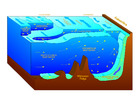
Plate tectonics - Black smoker
- Convergent boundary
- Divergent boundary
- Fracture zone
- Hydrothermal vent
- Marine geology
- Mid-ocean ridge
- Mohorovičić discontinuity
- Vine–Matthews–Morley hypothesis
- Oceanic crust
- Outer trench swell
- Ridge push
- Seafloor spreading
- Slab pull
- Slab suction
- Slab window
- Subduction
- Transform fault
- Volcanic arc
- More...
Ocean zones Sea level Acoustics Other - Alvin
- Argo
- Benthic lander
- Color of water
- Marginal sea
- Mooring
- Ocean
- Ocean energy
- Ocean exploration
- Ocean observations
- Ocean pollution
- Ocean reanalysis
- Ocean surface topography
- Ocean thermal energy conversion
- Oceanography
- Pelagic sediments
- Sea surface microlayer
- Sea surface temperature
- Seawater
- Science On a Sphere
- Thermocline
- Underwater glider
- Water column
- World Ocean Atlas
- NODC
- More...
Climate oscillations Climate oscillations 8.2 kiloyear event · Antarctic Circumpolar Wave · Antarctic oscillation · Arctic dipole anomaly · Arctic oscillation · Atlantic Equatorial mode · Atlantic multidecadal oscillation · Bond event · Dansgaard–Oeschger event · Diurnal cycle · El Niño-Southern Oscillation · Equatorial Indian Ocean oscillation · Glacial cycles · Indian Ocean Dipole · Madden–Julian oscillation · Milankovitch cycles · North Atlantic oscillation · North Pacific Oscillation · Orbital forcing · Pacific decadal oscillation · Pacific-North American teleconnection pattern · Quasi-biennial oscillation · Seasons · Solar variabilityCategories:- Tropical meteorology
- Physical oceanography
- Natural history of the Americas
- Natural history of Oceania
- Effects of global warming
- Climate patterns
- Weather hazards
- Spanish loanwords
Wikimedia Foundation. 2010.



